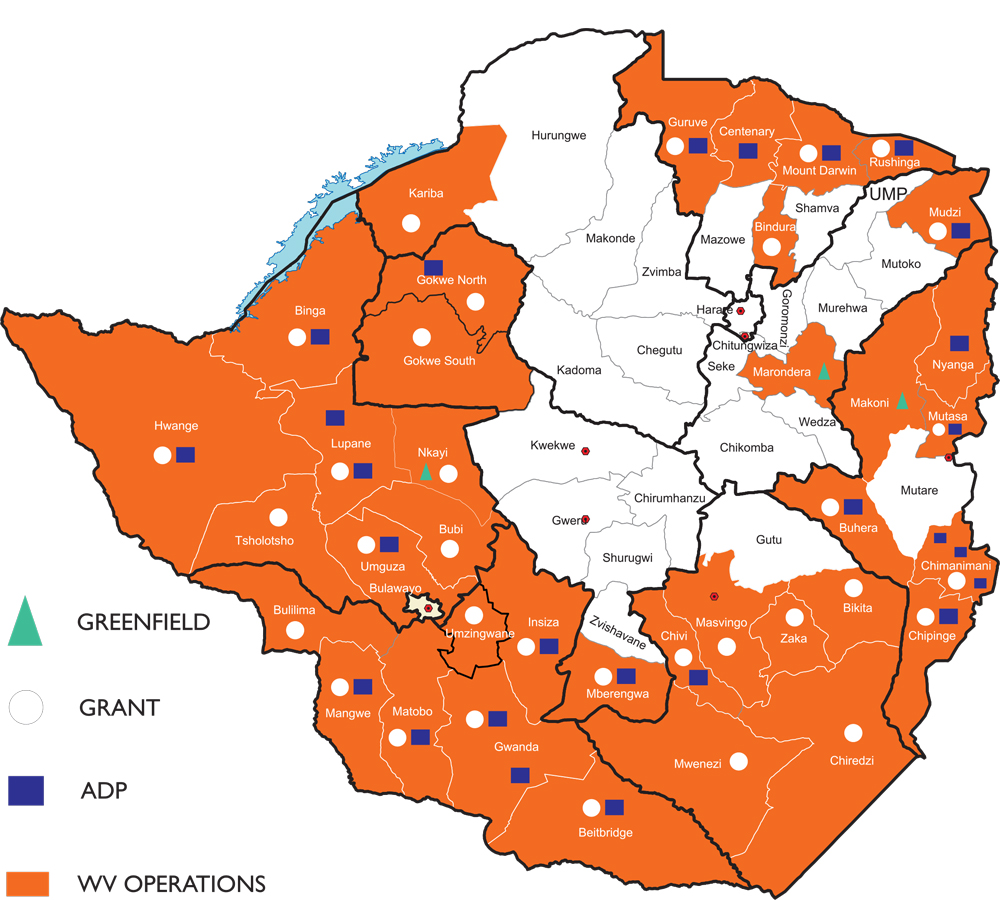Our Work
World Vision Zimbabwe (WVZ) has 31 Area Development Programs (ADPs) with over 70,000 currently sponsored by individuals from– the United States of America (USA), Australia, Canada, the United Kingdom (UK), Germany, Netherlands, Spain and Hong Kong.
WVZ manages about 10 grants in any given month, with donors that include DFID, USAID, OFDA, UN Agencies (DFAT, FAO, EU, UNICEF, UNFPA, and WFP) and 9 Support Offices that include Switzerland. In 2015, the total secured cash funding was US$41 million and value of Gifts-in-Kind (GIK) were over US$8.7 million (including US$3 million from the World Bicycle Relief), and a five-year ENSURE (Enhancing Nutrition, Stepping up Resiliency and Enterprise) Project funded by USAID covering Buhera, Chipinge and Chimanimani Districts of Manicaland Province with a budget of US$59 million over five years. As at May 2018, WVZ has a total of 30 active grants with a total cash portfolio value of US$74 million.
WVZ also implemented the European Commission funded Fisheries and Aquaculture Project which ran from 2013 to December 2017. The project was implemented in 8 districts of Masvingo, Matabeleland South, Mashonaland West and Matabeleland North provinces. Other recent large scale projects include the DFAT Australia funded Matabeleland South Integrated Health and Livelihoods programme and Civil Society Water, Sanitation and Hygiene Fund (Gwanda, Bulawayo) and the Maternal, Newborn, Child Health and Gender Equity Scale up Project (Buhera, Bulawayo & Mangwe) and these were recently completed.
The WVZ operations are spread across 9 out of the 10 provinces of the country, with a majority of its 1.75 million clients being in rural areas with programming focused on contributing to the sustained well-being of children. WVZ began its operations in 1973, working from the neighboring countries to providing life-saving support to refugees and Internally Displaced Persons (IDPs) during the Liberation Struggle.
After Independence in 1980 programming shifted towards working with institutions that were taking care of orphaned children. These included Mathew Rusike, Chinyaradzo Children’s home, Copota School of the Blind and Manhinga Villages for the Orphans among others. Driven by these preceding experiences the organisation switched to long-term development programming.
The mid 80’s saw WVZ adopting a long-term programming model frequently referred to as Community Development Projects (CDPs). These were clustered village development projects often characterized by funding from Support Offices (SOs), they covered small community projects. Operations were largely centralized, with World Vision support staff based in Harare and Bulawayo. These CDPs generated valuable experiences for World Vision’s future programmes.
In the early 90s WVZ moved to the large scale Area Development Programmes (ADPs). These are a cluster of the administrative wards (combined villages from one up to six). These ADPs are supported over a longer period of up to ten years or more and covering a larger area than the CDPs. These are supported with fairly larger resources than in the CDP scenario and staff are based in communities to give maximum support. Since the adoption of the ADPs the following older clusters have since transitioned Sengwe ADP (Chiredzi District), Chihoko (Mt. Darwin District), Uzumba Maramba Pfungwe (UMP District) and Inkosikazi ADP (Bubi District Dande (Guruve District), Hurungwe (Hurungwe District).
With the political and economic crisis of 1999-2009, interventions increased significantly to meet the growing humanitarian needs, peaking with the cholera outbreak and food security crisis of 2008-09, during which WVZ had as many as 1,900 staff serving 3 million Zimbabweans with food rations, Water & Sanitation services, health care provision, educational and micro-finance support, with a total programme value exceeding US$100 million.
